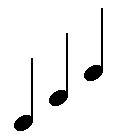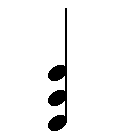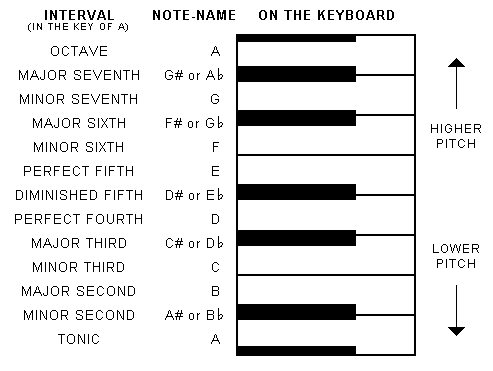Note
Tones in music are denoted by notes, which can take the form of either those particular visible markings in a printed musical score, or their referents. Notes per se are used to indicate the pitch and duration of tones in music, and do not represent other tonal qualities such as timbre.Rhythm
One of the fundamental elements of music is rhythm. As we all know, rhythm is a regular pattern in time. In Western music, rhythmic properties are represented for a piece by one or more time signatures, and, more importantly, for individual notes and rests by durations. Note durations are generally indicated by dissections and sub-dissections of a whole note.

Whole Note |

Half Note |

Quarter Note |

Eighth Note |
The relative duration value of any note can be increased by half, simply by placing a small dot in front of it.

Three-eighths |
The absolute duration value of a given note is a function of its relative duration value divided by the tempo of the piece of music to which it belongs. For example, for a piece the tempo of which is specified as sixty quarter-notes per minute, the absolute duration value of a quarter-note will be one second.
Melody and Harmony
Melody refers to the grouping of notes in sequence, usually conforming to a definite rhythm.

Melody |
Harmony is the superposition of notes.

Harmony |
A chord is a specific type of harmonic structure consisting of three or more simultaneous notes.
The permutations of note combinations are, of course, many and varied. However, only a fraction of possible note combinations are ordinarily used in the harmonic structure of a piece of music. Likewise, melodies will generally include only certain selected notes.
Intervals and Scales
An interval represents the difference in pitch between any two notes. A scale is a series of notes related to one another by intervals. A scale can arbitrarily consist of any number of possible intervals, but is generally limited to a selection of those notes corresponding to the tones in the harmonic overtone series. For most if not all scales, a series of notes is included in the range between the tonic, which is the note of lowest pitch in a scale, to the octave, which is the interval representing a tone exactly twice the fundamental frequency of the tonic.
In the Western chromatic scale, twelve intervals are included, representing harmonics, or integral divisions of harmonics, in the harmonic overtone series. The modern equitempered scale is based on these twelve intervals, but the intonation is such that all the intervals are mathematically adjusted so as to be evenly spaced in terms of frequency. This decision facilitates the transposition of a given piece of music or tonal combination to any of twelve keys, without altering the values of the intervals within the scale. As a consequence, however, none of the intervals perfectly corresponds to the harmonic series.
Interval Names
The intervals belonging to the twelve-tone, or chromatic, scale bear the following names:
- Unison (tonic)
- Minor Second
- Major Second
- Minor Third
- Major Third
- Perfect Fourth
- Diminished Fifth
- Perfect Fifth
- Minor Sixth
- Major Sixth
- Minor Seventh
- Major Seventh
The use of the term "perfect", retained from just intonation, which preserves the perfect correspondence of the intervals to the harmonic series, is a misnomer as applied to equal temperament.
The logical thirteenth interval, that is, the octave, is in a certain respect interchangeable with the tonic. The octave is exactly twice the frequency of the tonic, representing the first overtone and related to the fundamental in the simplest way. It is the point at which the scale completes a cycle, and at which the fundamental frequencies of all the intervals in any scale are doubled. A piece of music can be played in the key of the octave without actually being transposed.
Note-Names
Each interval in a scale, when set to a key, bears a certain note-name. These are denoted by the letters A through G, and can be modified by accidentals, including, most notably, sharps and flats.

Sharp |

Flat |
When, for example, a scale is set in the key of C, the tonic is referred to by the note C, the fifth by the note G, and the octave by the note C'.
Accidentals occur at certain intervals, depending upon the key. For the equitempered scale, the notes corresponding to these intervals can be referred to by one of two names, since they are related equally by a flat to the note immediately above, and by a sharp to the note immediately below. A graphical representation of the intervals and note-names of the equitempered chromatic scale is here displayed.
